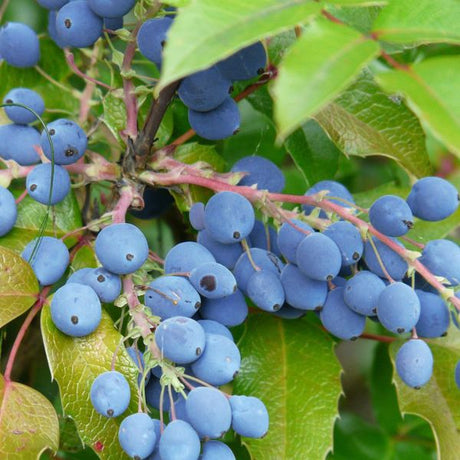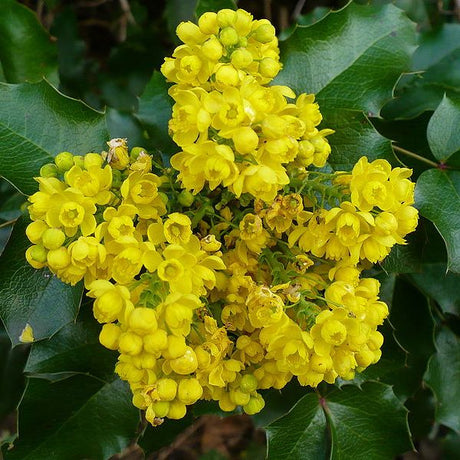- Sold outUp to 15% off
Mahonia aquifolium
Sale price From $4023 Regular price $4604Unit price /Unavailable
Native Trees For The State of Wyoming
Find the best selection of native species for the State of Wyoming here at Nature Hills Nursery and support native habitats in the Cowboy State!

Selecting trees native to your State ensures your tree is well suited to your climate and soil because they originated there! Evolving alongside these trees, pollinators and birds recognize these sources of shelter and forage.
Native trees need less water once established, plus native selections establish faster and tolerate the changing climate, weather, and anything else your State may have to offer.
Best Wyoming Native Trees
Wyoming is primarily an arid state with plains, valleys, volcanic plateaus, forests, mountains, woodland and shrubland-covered hills, where cattle, cowboys and the state bird, the Western Meadowlark, love to roam. Wyoming is USDA growing zones 3 to zone 6, featuring warm summers and cold winters, and a drier, windier climate.
Find your Hardiness Zone, and choose a tree that has a range that includes yours! Check with your local County Extension Office for more information if needed and for the many microclimates within these zones.
Best Native Evergreen Trees For Wyoming
These Wyoming native evergreen trees keep their leaves as year-round windbreaks, must stand up to storms, help block the drifting snow, and add interest during the winter months.
- Blue Spruce
- Colorado Spruce
- Douglas Fir Tree
- Eastern Red Cedar Tree
- Ponderosa Pine
- Shore Pine
- White Fir
- White Spruce Tree
Native Flowering Trees of Wyoming

Feed pollinators and hummingbirds nectar and pollen they evolved alongside in your State! Many of these trees are host plants for native pollinator larvae too!
- American Plum/Wild Plum Tree
- Black Locust Tree
- Pussy Willow Tree
What Native Shade Trees Can Be Found In Wyoming?
You need a good strong shade tree for the warm summers that handles winter chill, snow load and arctic cold. Some fall color and food for wildlife is a bonus! The grand Cottonwood tree is the State Tree, shading wide areas with these shining waving leaves! However, its close cousin, the Quaking Aspen, is the predominantly distributed tree in this state.
- American Elm Tree
- American Hop Hornbeam
- American Sycamore
- Ash Tree - Green & Mountain
- Paper Bark Birch
- Box Elder Tree (Boxelder)
- Cottonwood/Eastern Cottonwood Tree
- Common Hackberry & Sugarberry Trees
- Bur Oak Tree
- Quaking Aspen Tree
Native Fruit & Nut Trees in Wyoming
We love edible landscaping trees that look great and feed you and your local wildlife. Plant a few of these trees in your double-duty hedgerow for wildlife and you! Because of the primarily grassy landscape, wildlife appreciates the food and shelter.
- American Plum/Wild Plum Tree
- Butternut Hickory
- Saskatoon Serviceberry Tree
Much Needed Natives!
Help keep your State's native biodiversity intact by planting trees native to your area! Nature Hills is committed to helping you preserve your State’s unique beauty with plants and trees that are sure to do well in your garden without impacting your native landscape!
Whether you are adding shade or flowers, privacy, or a long-lasting legacy to your landscape, Nature Hills is here to help you find the perfect tree for your Wyoming landscape!

FAQ's for Buying Wyoming Native Plants Online
What trees grow best in Wyoming’s climate?
What trees grow best in Wyoming’s climate?
Trees that grow best in Wyoming are native species adapted to cold winters, dry conditions, and strong winds. These include hardy evergreens like Blue Spruce, Ponderosa Pine, and White Fir, as well as resilient deciduous trees like Quaking Aspen, Cottonwood, and American Elm. Choosing native trees ensures better survival and lower maintenance in Wyoming’s USDA Zones 3 to 6.
Are there evergreen trees native to Wyoming that provide year-round interest?
Are there evergreen trees native to Wyoming that provide year-round interest?
Yes, several evergreen trees are native to Wyoming and deliver year-round beauty and function. Popular choices include Colorado Spruce, Eastern Red Cedar, and Douglas Fir. These trees are excellent for creating windbreaks, blocking snow drifts, and adding visual appeal during the winter months when deciduous trees have lost their leaves.
Which native Wyoming trees are best for pollinators and wildlife?
Which native Wyoming trees are best for pollinators and wildlife?
Native flowering trees like the American Plum, Black Locust, and Pussy Willow support pollinators, hummingbirds, and native insects. Shade trees such as Cottonwood and Hackberry also provide habitat and food for birds and small mammals. Edible landscaping choices like Serviceberry and Butternut Hickory benefit both people and wildlife.
Can I grow fruit or nut trees in Wyoming using native species?
Can I grow fruit or nut trees in Wyoming using native species?
Yes, you can grow native fruit and nut trees in Wyoming for edible landscaping. Hardy options include American Plum, Saskatoon Serviceberry, and Butternut Hickory. These trees thrive in Wyoming’s challenging climate while producing nutritious food and supporting local ecosystems.
Why should I plant native trees in Wyoming?
Why should I plant native trees in Wyoming?
Planting native trees in Wyoming enhances biodiversity, supports local wildlife, and reduces the need for irrigation and chemical inputs. Native trees are better adapted to Wyoming’s soil, climate, and weather patterns, leading to stronger establishment and long-term growth with minimal care.


